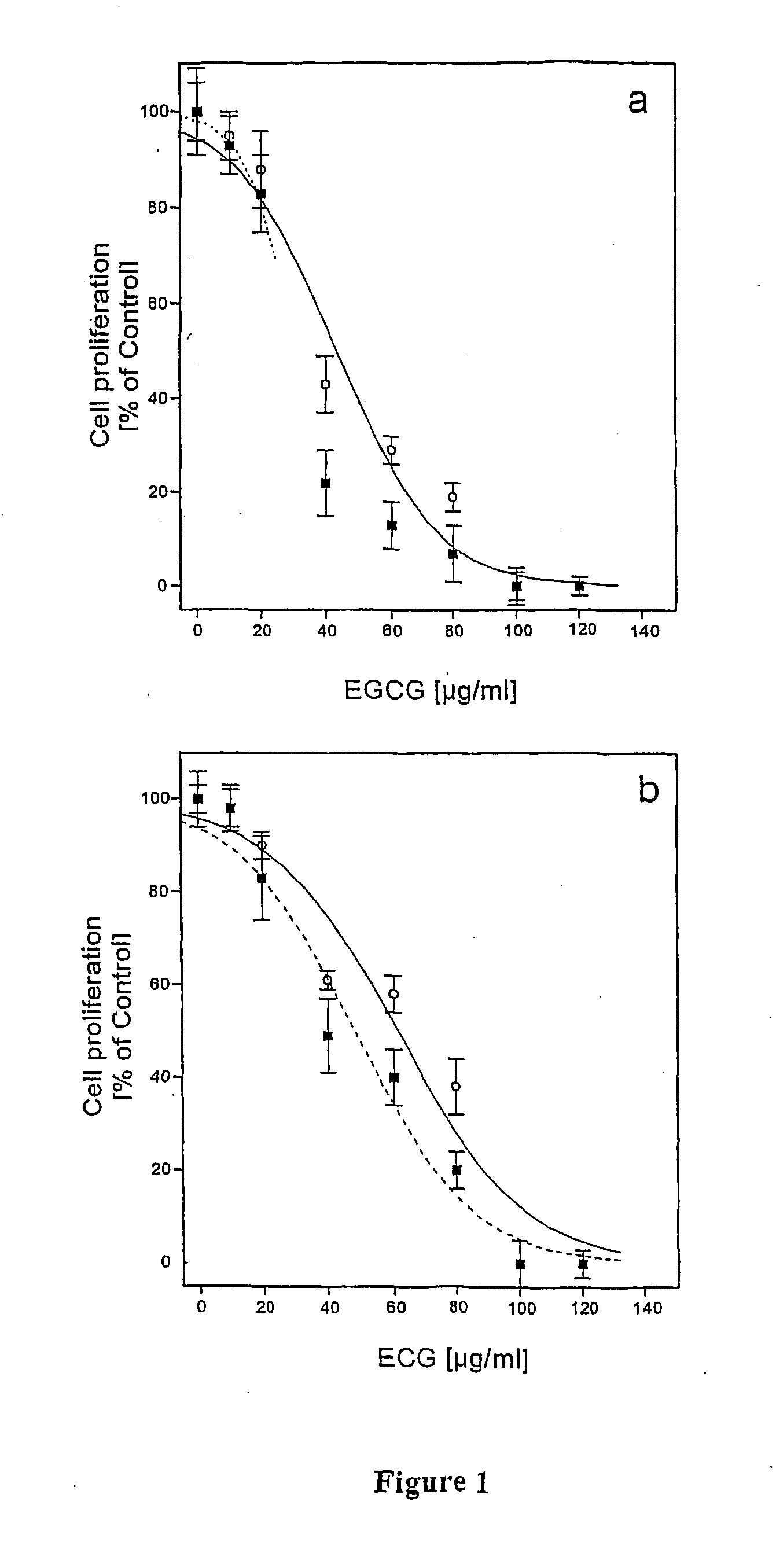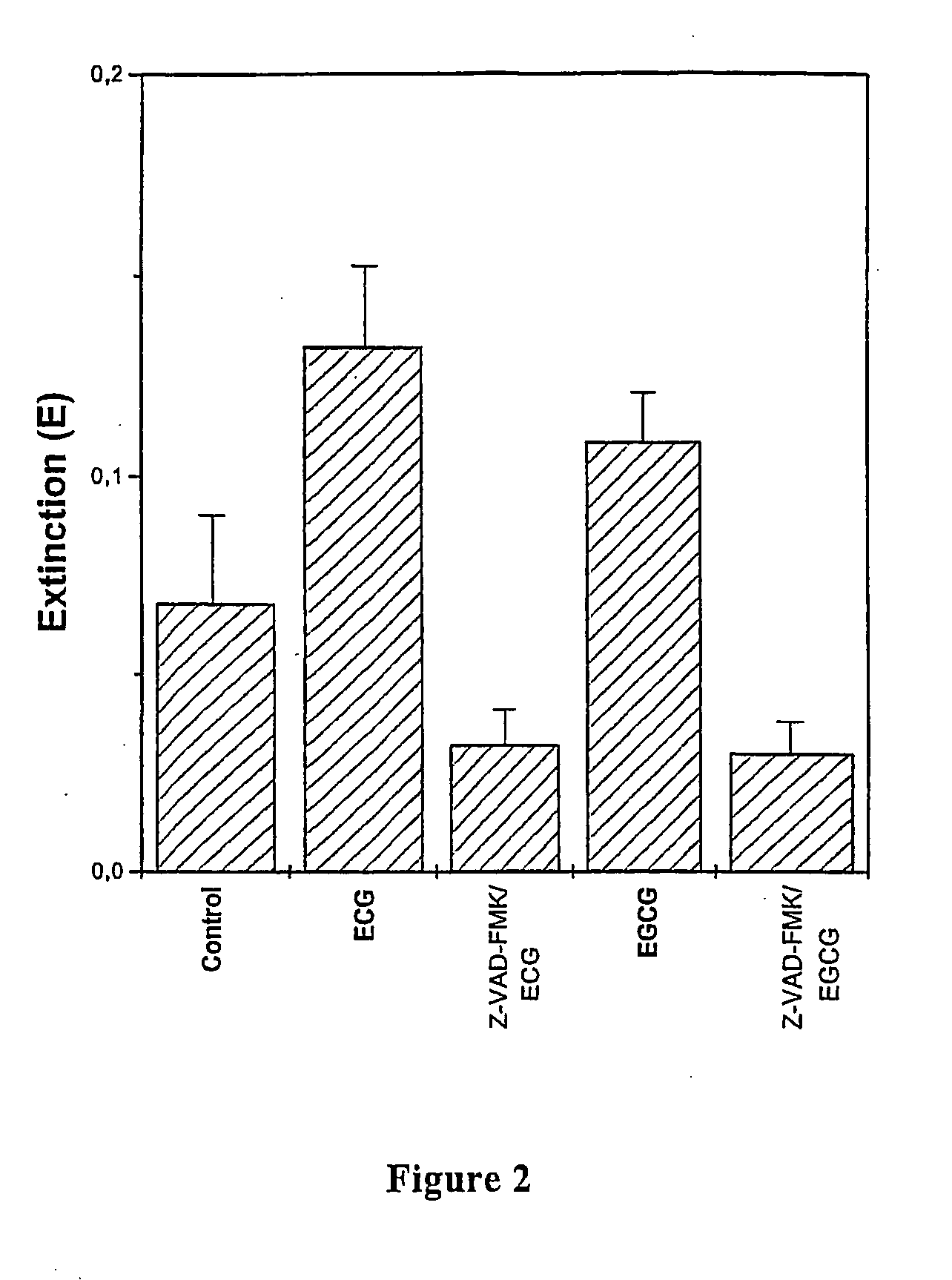Extract of ceratonia siliqua leaves and pods containing polyphenols with antioxidant and antitumor activities
- Summary
- Abstract
- Description
- Claims
- Application Information
AI Technical Summary
Problems solved by technology
Method used
Image
Examples
example 1
[0020] Preparation of Standards and Samples
[0021] Standards consisted of a mixture of (+)-catechin (C), (-)-epicatechin (EC), (-)-epigallocatechin-3-gallate (EGCG), (-)-epicatechin-3-gallate (ECG), gallic acid (GAc), theophylline (T), caffeine (Ca), chlorogenic acid (ClAc), caffeic acid (Cac), catechol (Ct) and tea extracts, containing teaflavin, teaflavin-3 -monogallate, teaflavin-3 '-monogallate and teaflavin-3,3'-digallate (with purity >80%) were prepared dissolving known amounts of all the analytes in the mobile phase used for the chromatographic separation so as to reach concentrations from 0.3 to 500 gg / ml. Samples were prepared by infusing 1 g of carob leaves or pod meal in 100 ml of hot distilled water for 15 min. Afterwards, the aqueous extract was centrifuged at 13,000 rpm for 10 min, then filtered through PTFE 0.22 .mu.m filters. A second aqueous extract was obtained from the centrifugation residue.
example 2
[0022] Chromatographic Analysis
[0023] The chromatographic separation was carried out with an analytic Microsorb RP-C.sub.18 100 A column (250.times.4.6 mm), thermostatized at 40.degree. C, using a gradient with starting composition: 68% water, 22% of 0.5% phosphoric acid, 4% acetonitrile and 6% methanol, linearly increasing the organic solvents with a flow of 1 ml / min. UV-Vis absorption spectra (.lambda.=198-708 nm) were recorded continuously and the samples absorption peaks were identified by comparing retention times and UV-Vis spectra with those of the standard. The peak area at 205 nm was used to establish calibration curves.
1TABLE 1 Catechins quantitation by chromatographic analysis CAROB LEAVES CAROB MEAL mg / g .+-. s.d.* mg / g .+-. s.d.* 1.sup.st infusion 2.sup.nd infusion Total 1.sup.st infusion 2.sup.nd infusion Total G Ac 3.34 .+-. 0.032 0.96 .+-. 0.020 4.30 0.87 .+-. 0.000 0.33 .+-. 0.007 1.20 EGC ---- -- 0.05 .+-. 0.000 0.01 .+-. 0.001 0.06 C -- -- -- 0.01 .+-. 0.000 -- 0....
example 3
[0024] Pharmacological Experimentation
[0025] Cell cultures
[0026] Tumour cell cultures (T1) used in the tests derive from transgenic mice hepatocellular carcinoma, in which an over-expression of the c-myc and TGF.alpha.had been induced. Cells were kept in L-glutamine-free DMEM medium, HAM F 12 containing 1 mg / ml galactose, 18 mM HEPES, 5 mM Na piruvate, 30 mg / Ml proline, ITS 100.times., 2 mM glutamine, 0.1% gentamicin (Sigma-Aldrich, Italy) and added with 10% FBS. Cell lines were cultured in polystyrene plates (Dasit, Italy).
[0027] Cell Proliferation Assay
[0028] T1 cells were plated in 96 wells-plates at a concentration of 10,000 cells / well and left to sediment for 4-5 hours. Cells were then incubated in EGCG or ECG at a concentration of 20, 40, 60, 80, 160 .mu.g / ml for 24 and 48 hours. The substances were diluted in the culture medium starting from stock solutions (aqueous solution for EGCG and aqueous-ethanol solution (1:1) for ECG). Control cells were treated with solutions contai...
PUM
 Login to View More
Login to View More Abstract
Description
Claims
Application Information
 Login to View More
Login to View More - R&D Engineer
- R&D Manager
- IP Professional
- Industry Leading Data Capabilities
- Powerful AI technology
- Patent DNA Extraction
Browse by: Latest US Patents, China's latest patents, Technical Efficacy Thesaurus, Application Domain, Technology Topic, Popular Technical Reports.
© 2024 PatSnap. All rights reserved.Legal|Privacy policy|Modern Slavery Act Transparency Statement|Sitemap|About US| Contact US: help@patsnap.com









